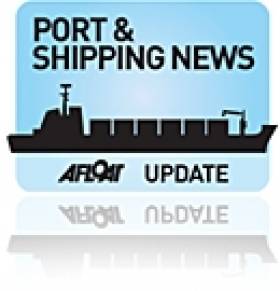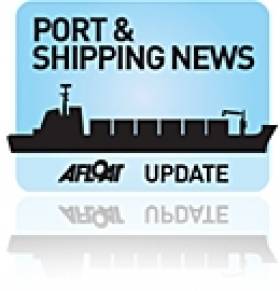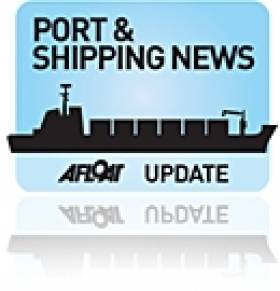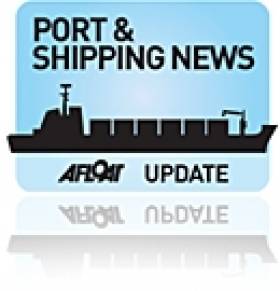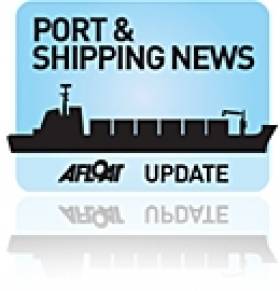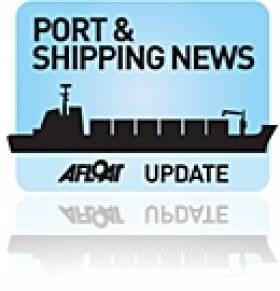Displaying items by tag: Ports & Shipping Review
Ports & Shipping Review: Maritime Labour Package, Shipping Sector Steady Course, Ferry Service 40th, New Cruise Terminal plus more..
#ShippingReview: Over the last fortnight Jehan Ashmore has reported from the shipping scene where Minister for Transport, Leo Varadkar confirmed a successful Irish Presidency trilogue which dealt with the Maritime Labour Package.
Celtic Link Ferries recorded an increase in both passenger and vehicle traffic for the month of May compared to same period in 2012.
A new ferry route linking Campeltown on the Mull of Kintyre peninsula and Ardrossan on the Firth of Clyde via the Isle of Aran began operations, the first new service for nearly 20 years by CalMac in the region.
Irish based shipping companies (340 vessels) in 2012 experienced a challenging year in operations both with domestic and international, according to the Irish Maritime Development Office (IMDO).
Celebrating this month is the 40th anniversary of Irish Continental Line's Ireland-France route served by Saint Patrick, the service's successor is operated by Irish Ferries.
Cork based Ardmore Shipping's newly launched 49,999dwt tanker Ardmore Seaventure built by SPP Shipbuilding in Korea, was immediately delivered to Cargill on a 12 month time charter arrangement.
Ireland's first custom-built cruise terminal costing £7m is planned for Belfast Harbour, the new facility will be able to handle the next generation ships which carry over 4,500 passengers and crew.
The seized bulk-carrier Clipper Faith (1998/19,354grt) has been sold at auction for €4.8m to Greek owners.
Ports & Shipping Review: Galway Port 99%, X-Bow Call, Detained Cargoship, Cruise Liffey, New Pilot RIB and QM2
#ShippingReview: Over the last fortnight Jehan Ashmore has reported from the shipping scene where plans for the expansion of Galway Harbour are "99 per cent ready to go".
The increasing strategic importance of Cork Harbour as a base for the oil and gas energy sector was clearly evident with the call of the unusual looking 'X-Bow' platform supply vessel Bourbon Clear.
A High Court judge expressed concern for the crew of Clipper Faith, a Belize registered 19,000 tonnes cargo ship detained in Dublin Port who have not been paid since late last year.
As referred above the Clipper Faith which has been in the port since March shifted berths so to accommodate French cruiseship Le Boreal to the East-Link toll-bridge.
The 'cruise' berth is situated much closer up the Liffey and is where larger visiting cruiseships are to moor as Dublin Port plans to develop deep-water berths for a proposed new cruise terminal.
Irish Rigid Inflatable Boat (RIB) builder Red Bay Boats is exhibiting one of its giant 16–metre Pilot Boat Stormforce RIBs at next month's Seaworks commercial exhibition in Southampton.
On the same day of the historic call of the dual serving liner and cruiseship Queen Mary 2 off Dun Laoghaire, expedition cruiseship Serenissima docked within the harbour walls, while another caller was made by Artania to neighbouring Dublin Port.
#ShippingReview – Over the last fortnight, Jehan Ashmore has reported from the shipping scene, where Minister for Justice, Alan Shatter outlined one of Ireland's EU Presidency priorities, to address the potential to enhance Maritime Safety, Security and Surveillance in the EU.
Plans for the proposed €350m development of the deep-water port at Bremore, near Balbriggan, Co. Dublin, has been effectively shot down under the government's new National Ports Policy.
The IMDO Weekly Shipping Market Review reported production of Irish manufacturing industries for February 2013 was 0.2% higher than the previous month according to figures released from the CSO.
The European Parliament has rejected proposals to introduce a levy on all ships calling at EU ports that would finance a fund to support sustainable recycling of ships.
A marine notice (no.17) from the Department of Transport, advises on two minor amendments to ship security plans and on-board retention of security records, in accordance with Regulation (EC) No 725/2004 and the International Ship and Port Facility Security Code (ISPS Code).
#ShippingReview – Over the last fortnight, Jehan Ashmore has reported from the shipping scene, where Minister for Transport Leo Varadkar, launched the National Ports Policy which is to radically overhaul commercial ports and the transfer of 'regional' ports to local authorities.
Among the proposed regional ports is Dun Laoghaire, where the harbour which is in the middle of the town is expected to focus on tourism, cruise liners and marine leisure activity.
In regards to larger strategic ports, (noting Port of Cork development update) they are charged with leading the response to national capacity requirements, something that is long overdue because port capacity has not been matching growth in traffic for either unitised and non–unitised cargo.
The policy follows the launch of a 30–year masterplan for Dublin Port Company over a year ago and the launch of the Shannon Estuary masterplan announced in February.
Responding to the National Ports Policy, the Irish Ports Association (IPA) which is the representative body for the Irish ports sector and an affiliate of IBEC welcomed the publication which sets out the policy framework for the future development of the sector.
Amidst snow flurries and gusts up to 34 knots, the cargoship Blue Tune departed Dun Laoghaire Harbour having discharged the final round of fermentation tanks bound for Guinness's St. James's Gate Brewery in central Dublin.
The Antigua and Bermuda flagged vessel, was the third such ship to dock in Dun Laoghaire Harbour since mid-February and the return of cargo ships marks a trade not seen in the port for more than two decades.
Ports & Shipping Review: Ardmore Name Tankers, Maersk Opt for Suez, Ireland’s Globalised Status, Short-Sea ‘Steady’ and Last Guinness Tanks
#ShippingReview – Over the last fortnight, Jehan Ashmore has reported from the shipping scene, where Cork based Ardmore Shipping named two of their latest newbuild product chemicals tankers at a South Korean shipyard.
According to the IMDO's Weekly Shipping Market Review, Maersk Line, is looking to change its path for the trade lane of Asia to US East Coast, by opting for the Suez Canal as opposed to the current Panama Canal.
In addition the IMDO review reports that Ireland has been ranked the world's third most globalised economy in terms of GDP, and the most globalised nation in the western world, according to Ernst and Young. As for the European Short Sea Market, this has been summarised as "steady/flat", according to HC Shipping & Chartering".
The cargsoship Blue Tune (2010/3,845grt) which currently is docked in Dun Laoghaire Harbour, is understood to have arrived with the final batch of fermentation tanks bound for the Guinness brewery plant in Dublin.
Ports & Shipping Review: Cattleship Reaches Libya, Another Round of Guinness, Duke Visits Dublin, ShortSea '13, New Cork Port Chairman and more…
#ShippingReview – Over the last fortnight, Jehan Ashmore has reported from the shipping scene, where the trade in live-cattler exports to Libya, not seen since the mid-1990's, finally reached conclusion when livestock-carrier Express I docked in Misrata.
The 'ghost' ship Lyubov Orlova, which broke its tow-line in the Atlantic and believed to have possibly sunk, is a sister of the first ever cruiseship caller to Drogheda Port last year.
The Royal Navy's Type 23 Duke Class frigate HMS Richmond (F239) which has a displacement of 4,900 tonnes made a weekend courtesy call to Dublin Port.
A sister of the frigate which featured in a Bond movie starring Pierce Brosnan, by coincidence passed Dalkey on the same day, where the Irish actor was on location for a TV advert.
Next week, on Thursday (14 March), the European Shortsea Conference 2013 is to take place for the first time in France.
A new chairman for the Port of Cork Company, businessman John Mullins has been appointed by Minister of Transport Leo Varadkar.
Another round of Guinness fermentation tanks arrived into Dun Laoghaire Harbour, where Sunday strollers watched as the cargoship Keizersborg (1996/6,142grt) docked at the old 'mail' boat pier.
Commissioners of Irish Lights ILV Granuaile (2000/2,625grt) an aids to navigation tender vessel, is undergoing steel modification works by Arklow Marine Services while berthed in Dublin Port.
The 5 April is the deadline for members of the public to the Department of Transport, regarding plans to merge Bantry Bay Harbour with the Port of Cork Company.
The Irish Continental Group (ICG) parent company of Irish Ferries, have released a statement of results for the year ended 2012.
A new container sea-rail-freight service between Waterford Port (Belview) and Ballina, Co. Mayo began operating to link in with sailing schedules by DFDS Logistics vessels running to Rotterdam.
Ports & Shipping Review: Ferry Takes a Battering, Busy Port, Aircraft-Carrier’s Valentine Call, Tanks for Guinness, Cattleship for Libya and much more …
#P&SReview – Over the last fortnight, Jehan Ashmore has reported from the shipping scene, where at Dover, P&O Ferries protested to the Office of Fair Trading over Eurotunnel's bid to manage Calais and Boulogne ports.
The Marine Institute's RV Celtic Explorer called to Dublin Port in between scientific surveys, one in which included a Methane-derived Authigenic Carbonate (MDAC) survey some 25 nautical miles offshore of Dublin Bay.
As a snapshot of Drogheda Port's shipping scene, nine cargoships called within 48 hours, demonstrating the busy Co. Louth port which handled more than 1m tonnes of cargo last year
Passengers booked on a Celtic Link Ferries sailing from France in advance of St. Patrick's Day, will be taking advantage of a special €1 euro fare as part of the year's 'Gathering'celebrations.
Britain's last aircraft-carrier HMS Illustrious (R06) now used as a helicopter commando carrier visited Liverpool on St. Valentine's Day and was open to the public as part of a five-day courtesy call.
Surprised onlookers along Dun Laoghaire's East Pier saw a cargoship, Myrte (6,120 tonnes) loaded with huge silver cylinders. In fact they were fermentation tanks bound for the Guinness St. James Gate Brewery. The tanks were unloaded at Carlisle Pier for onward delivery by road convoy.
An incident involving stabilisers of chartered ferry Finnarrow to Stena Line, while berthing in Holyhead, led to an evacuation of passengers and crew. Stena were forced to reactivate the HSS fastcraft on the route to Dun Laoghaire.
After a break of more than 17 years, a cattleship docked in Waterford, following the lifting of a ban by Libya on beef imports when the BSE (mad cow) disease broke out in Ireland.
There was a mixed response by ESPO and other European organisations to the EU's deal of a budget of €23 billion for transport infrastructure projects over the next seven years.
The UK's Competition Commission has provisionally found that passengers and freight customers could face increased prices following Eurotunnel's acquisition of SeaFrance between Dover-Calais.
Irish Ferries set sail for France when Oscar Wilde launched the 2013 season with a night-time departure on the Rosslare-Cherbourg route.
Transport Minister Leo Varadkar announced a €7.4m funding for a Safety Programme to carry out urgent remedial works at six regional harbours.
Not only were Stena Line forced to reactivate fastcraft HSS Holyhead-Dun Laoghaire sailings earlier than planned (continuing into summer season) but also send in for freight-ferry, Stena Scotia, on the Dublin route following the damaged chartered Finnarrow, currently berthed in Greenock.
On the Celtic Sea, French ferry operator Brittany Ferries Cork-Rosscoff route opens on 23 March for the season service served by flagship Pont-Aven.
Ports & Shipping Review: Fenit’s Crane Exports, Cork’s Energy Deal, Belfast’s Tonnage Record, Grounded Airbus Wingship Re-floated plus more…
P&SReview – Over the last fortnight, Jehan Ashmore has reported from the shipping scene, where the Stade, a cargo vessel rode out bad weather before docking at Fenit to load cranes built by Liebherr in Killarney, which as previously reported has received an order from the New Zealand port of Lyttelton.
The Port of Cork Company have signed up with Sustainable Energy Authority of Ireland (SEAI) in targets for improved energy efficiency set for 2020.
Drogheda Port handled over 1m tonnes of cargo, this level in throughput has not been surpassed since 2007. The Co. Louth port is to welcome a flotilla of tallships during the Drogheda Fringe Festival over the May Bank holiday.
For the first time, Paris will host this year's European (Shortsea '13) Conference on 14 March at La Defense. Last year the IMDO hosted the event in Dublin's Mansion House.
Ports across Europe urged governments not to touch the envelope of €31.7billion foreseen for Europe's transport infrastructure investments under the Connecting Europe Facility (CEF).
Belfast Harbour had a record 19.6m tonnes in 2012, up 11% on the previous year. The growth was primarily driven from the bulk and roll-on/roll-off (freight) sectors.
Irish Ferries fast-craft catamaran Jonathan Swift, returned fresh from dry-docking, she operates the Dublin-Holyhead route, where she clocks up an impressive 162,000kms each year.
A grounded ship that carries wings for the Airbus A380, Ciudad de Cadiz (2008/15,643grt) was re-floated yesterday, having broke moorings during a gale in late January off the Welsh port of Mostyn.
Ports & Shipping Review- Research Vessel Returns, Record Cruise Season, Fast & Slow Ferry Refits, Port Upgrade and Riverferry's Fate?
#ShippingREVIEW- Over the last fortnight, Jehan Ashmore has reported from the shipping scene, where the Geological Survey of Ireland (GSI) research vessel Keary, returned to Dun Laoghaire Harbour following modification work at Arklow Marine Services.
A record total of 64 cruiseships are to call to Cork Harbour, making the 2013 season the busiest year to date and includes six maiden calls and two cruiseships will make overnight calls.
The New Year brought changes at Ardmore Shipping, where new promotions have been made for personnel at senior management level.
Not a single fast ferry is to be found operating on the Irish Sea, not to bad weather, but for the brief absence of Irish Ferries Jonathan Swift, currently in refit, from year-round Dublin-Holyhead service.
One of Stena Line's Dublin Port-Holyhead route ships, Stena Nordica is on relief duty, covering for Stena Europe between Rosslare-Fishguard. In place of the 'Nordica' Dublin sailings, the chartered Finnarrow is maintaining sailings to Holyhead.
A major upgrade of the Scottish ferryport of Cairnryan, on Loch Ryan, has begun to improve operations for P&O Ferries short-sea route to Larne.
According to the Port of Cork, a total of 9.05 million tonnes in trade traffic levels was reached at the end of 2012, not since 2008, has the port surpassed 9m tonnes.
Royal Daffodil, one of the famous Mersey Ferries fleet due to be withdrawn, has been discussed with the National Waterways Museum, but no decision has been made as of yet.
The efforts of Cruise Belfast has paid off as the 2013 cruise season is to be a record year with close to 60 calls bringing more than 100,000 visitors to Belfast Harbour.


























